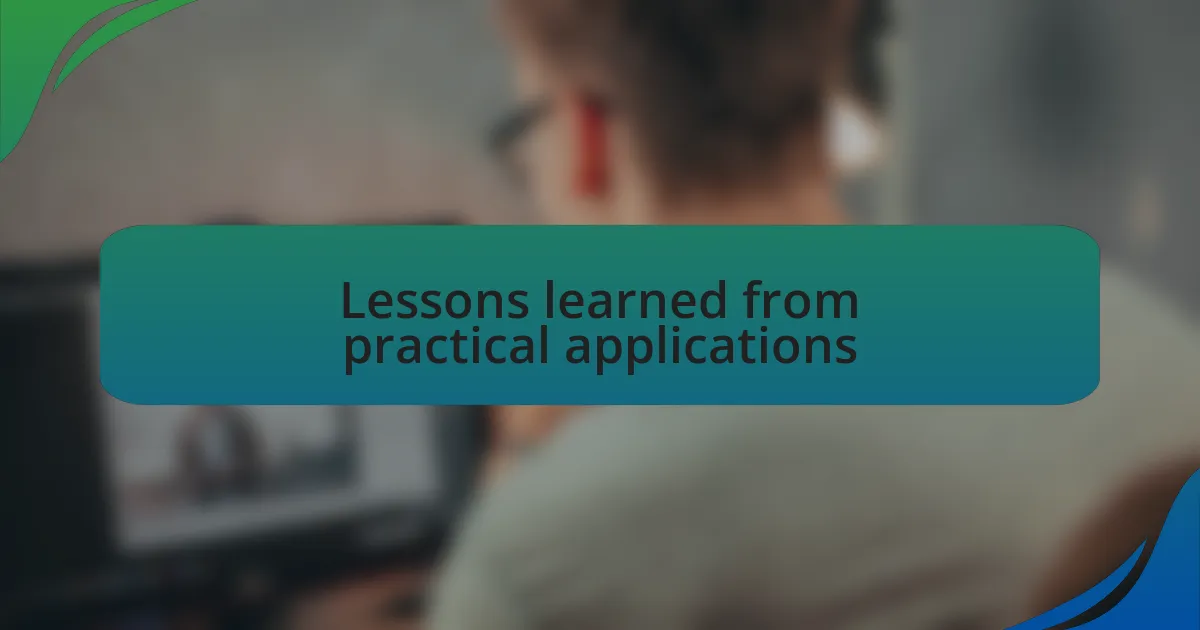Key takeaways:
- Market segmentation is vital for tailoring marketing efforts and engaging with specific customer groups effectively.
- Understanding consumer demographics, psychographics, geography, and behavior enhances resource allocation and customer loyalty.
- Focused segmentation allows SMEs to identify profitable niches, streamline decision-making, and uncover growth opportunities.
- Utilizing data analytics and continuous testing can significantly improve segmentation strategies and customer engagement.

What is market segmentation
Market segmentation is the process of dividing a broad target market into smaller, more manageable segments based on shared characteristics. This can include demographics, psychographics, geographical locations, or behavioral traits. I remember when I first encountered this concept; it was like discovering a hidden treasure map. Realizing how effectively it could guide businesses to tailor their products was a game-changer.
Consider a small bakery trying to attract customers. If they just marketed to everyone, they might miss out on specific groups like health-conscious eaters or busy professionals looking for quick snacks. Segmenting the market helps pinpoint where to focus marketing efforts. I once advised a local café on this, and by creating targeted offers for families with children, they significantly increased their foot traffic.
Embracing market segmentation is not merely an academic exercise; it can feel personally satisfying, too. The thrill of crafting personalized messages that speak directly to different audience segments brings a genuine connection. Isn’t it exciting to think about how effectively we can engage with our customers when we understand their unique needs and preferences?

Importance of market segmentation
Understanding the importance of market segmentation is crucial for any business, especially for SMEs looking to thrive. When I worked with a small fashion retailer, we discovered that their sales skyrocketed after targeting young professionals instead of a broad audience. This focused approach allowed them to design marketing campaigns that truly resonated with a specific demographic, proving that knowing your audience can lead to better results.
One of the most significant advantages of market segmentation is the ability to allocate resources more efficiently. In my experience, businesses that neglect this principle often find themselves wasting time and money on ineffective marketing strategies. I recall a small tech startup that tried to appeal to everyone; they ended up with a diluted brand message and minimal engagement. Focusing on segments allowed them to create tailored solutions that actually met the needs of their ideal customers.
Moreover, market segmentation also enhances customer loyalty. I remember a targeted email campaign I developed for a local gym that focused on fitness enthusiasts rather than general fitness seekers. The response was phenomenal, and we saw not only increased sign-ups but also higher retention rates. When customers feel understood and valued, they’re more likely to stay loyal, don’t you think?

Types of market segmentation
When considering market segmentation, I typically categorize it into four main types: demographic, geographic, psychographic, and behavioral. For instance, in my work with a food delivery service, we found that segmenting by demographic factors—such as age and income—could significantly improve our targeted offerings. We discovered that young families valued convenience over price, while college students were more focused on budget-friendly meals. This insight shaped our marketing and promotional strategies effectively.
Geographic segmentation, on the other hand, can often reveal local preferences that might be overlooked. I once got involved with a regional landscaping company that had distinct offerings depending on the climate and local plant preferences. By tailoring our services based on these geographic insights, we managed to resonate with the specific needs of the communities we served. Isn’t it fascinating how geography can influence buying behavior and preferences?
Then there’s psychographic segmentation, which dives into the mindset and lifestyle of customers. I remember collaborating with a wellness brand that distinguished customers based on their values—such as sustainability and health consciousness. Crafting marketing messages that aligned with these values led to an almost emotional connection with the audience. It made me realize that reaching customers on a deeper level often results in profound loyalty and engagement. What do you think about exploring these intricate facets of what drives consumer behavior?

Role in SME development
Understanding the role of market segmentation in SME development is crucial. From my experience, segmenting the market allows small and medium enterprises to tailor their products and services to specific needs. I recall a time when I worked with a startup that focused on eco-friendly products. By honing in on environmentally conscious consumers, we were able to create a brand identity that resonated deeply with our target audience. This clarity not only guided our marketing efforts but also sparked meaningful conversations with customers who shared our values.
Moreover, market segmentation simplifies decision-making for SMEs by highlighting the most profitable segments. I once advised an SME in the tech industry that had been casting a wide net with its offerings, resulting in diluted efforts and resources. By narrowing their focus to tech-savvy middle-aged professionals, they found a more engaged customer base willing to invest in their products. Isn’t it interesting how narrowing your focus can sometimes lead to broader outcomes?
Finally, market segmentation acts as a map for growth strategies within SMEs. In my work with a local boutique, we analyzed customer purchasing patterns and discovered a hidden segment of working women who preferred versatile clothing. This realization prompted us to expand our product line, which ultimately led to a significant boost in sales. It’s a powerful reminder of how knowing your audience can unveil opportunities that might otherwise remain unnoticed. How many potential markets are waiting for you to discover them?

My experiences with market segmentation
Market segmentation has been a real eye-opener for me in my professional journey. I remember collaborating with a skincare brand that was struggling to connect with its audience. By segmenting their market into different age groups, we tailored messaging that resonated specifically with millennials. It was incredible to see how a focused approach transformed their engagement levels and ultimately led to a surge in sales.
One of my memorable experiences was with a food startup that initially catered to everyone. It was only when we identified health-conscious consumers as a key segment that things started to click. I felt a spark of excitement when we rebranded the product line, making it healthier and more appealing to that niche audience. Witnessing the direct impact of our segmentation strategy reinforced my belief in its essential role in driving growth.
I often find myself reflecting on the times when I helped businesses uncover segments they hadn’t previously considered. For example, I once worked with a fitness studio that realized their client base included many new parents looking for convenient workout solutions. Encouraging them to create tailored classes for this group not only strengthened their community feel but also fostered loyalty. Isn’t it fascinating how understanding your customers’ varied needs can lead to such fruitful opportunities?

Strategies for effective segmentation
Effective segmentation isn’t just about dividing your market; it’s about identifying the right strategies that truly resonate. For instance, I once guided a tech startup that aimed at both young professionals and retirees. By implementing a strategy that focused on personalized marketing for each segment, we crafted distinct value propositions—like user-friendly tutorials for seniors and sleek, cutting-edge features for the younger audience. The outcome was astonishing; the feedback indicated that both groups felt specifically catered to, enhancing their connection with the brand.
A strategy that I find immensely useful is leveraging data analytics to inform segmentation decisions. When I worked with a retail client, we used purchasing patterns and demographic data to create detailed customer personas. This data-driven approach not only identified specific trends but also revealed emerging needs within each segment we hadn’t previously recognized. Have you ever noticed how data can unveil opportunities that intuition alone might miss?
Lastly, continuous testing and adapting is crucial for effective segmentation. In a project with an online education platform, we tested various formats and subject lines for different age groups. When we discovered younger audiences preferred bite-sized content while older generations favored in-depth courses, it was a game changer. The thrill of tweaking approaches based on real-time feedback is something I always cherish. It reminds me that segmentation is a dynamic process, not a one-time task. How often do we reevaluate our strategies to ensure they still align with our customers’ evolving preferences?

Lessons learned from practical applications
Working with a fitness app startup taught me invaluable lessons in market segmentation. When targeting both fitness enthusiasts and casual users, I initiated user interviews, uncovering differing levels of motivation and engagement. It was eye-opening to realize how understanding the emotional drivers behind user choices led us to tailor features that truly resonated with each group, such as community challenges for enthusiasts and simple tracking features for casuals. Have you ever stopped to think about what truly motivates your customers?
In another experience, collaborating with a local bakery highlighted the importance of local demographics in segmentation. By analyzing neighborhood preferences, we discovered that offering gluten-free options significantly appealed to a growing segment of health-conscious customers. This small shift in product offerings not only increased sales but deepened our connection with the community. Isn’t it amazing how local insights can pave the way for meaningful engagement?
One lesson I always emphasize is the power of emotional appeal in segmentation. While working with a non-profit focused on youth development, I observed that segments motivated by personal stories often engaged more deeply than those driven by statistics. Sharing testimonials from beneficiaries created a powerful emotional pull, reinforcing connections. Isn’t it fascinating how a well-placed story can shift perceptions and inspire action?